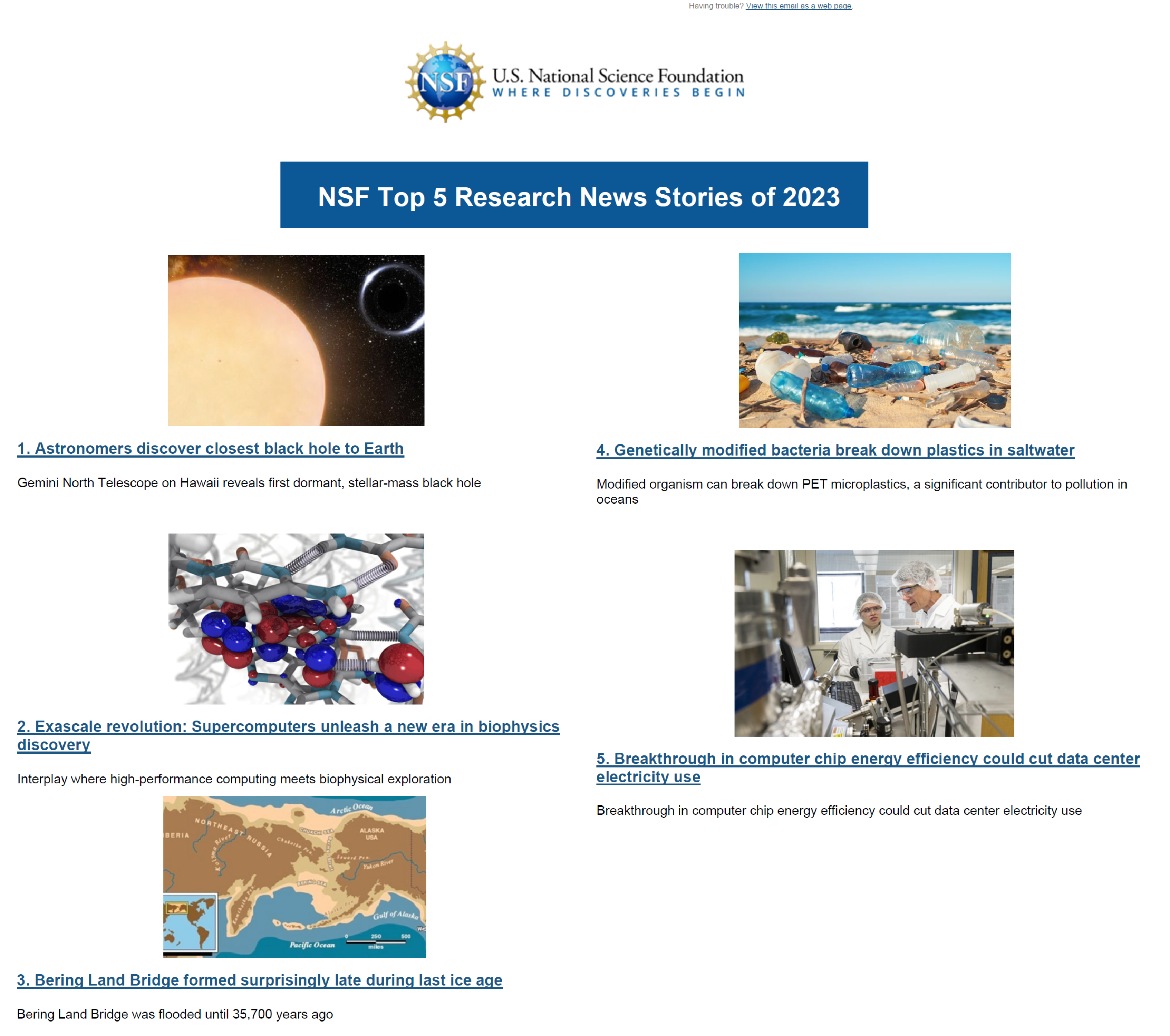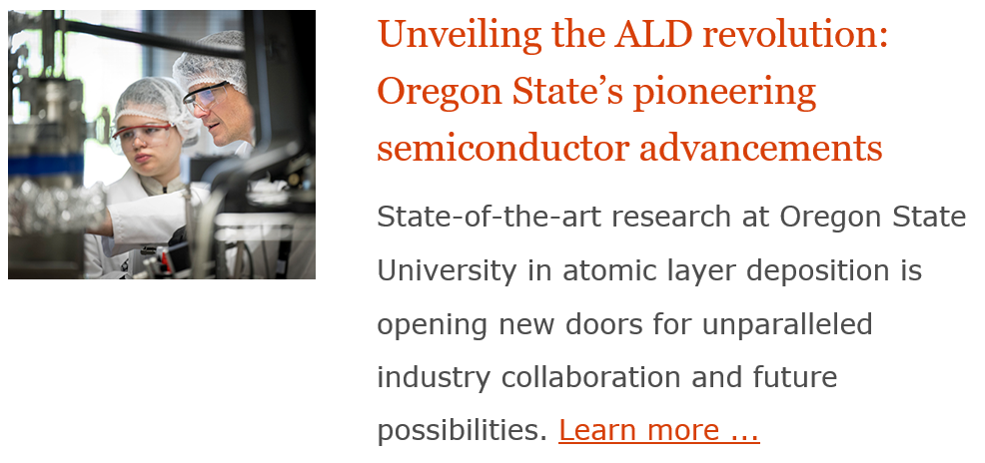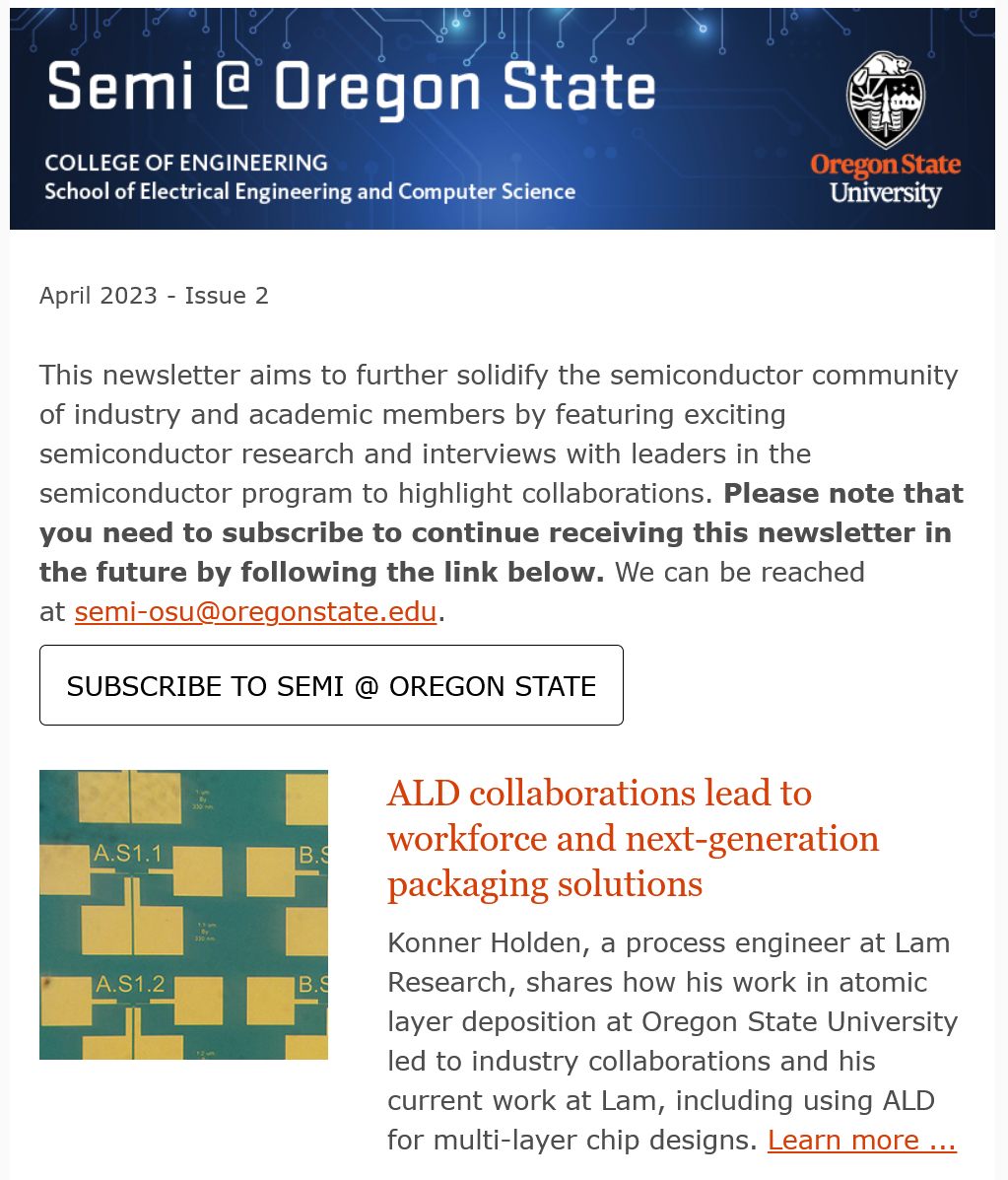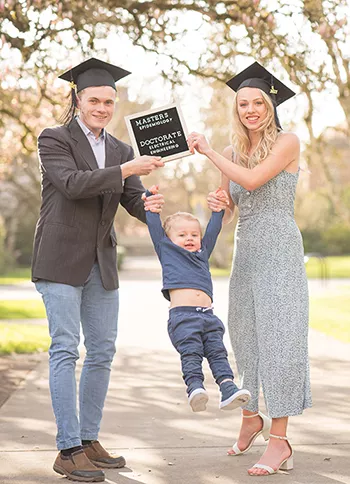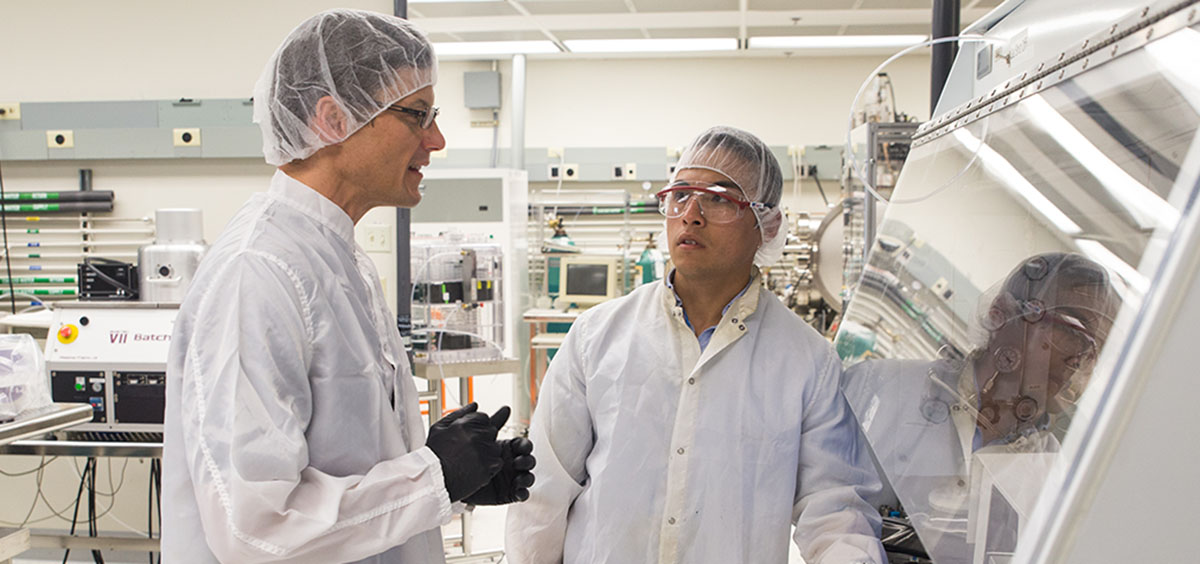Conley Group Emerging Materials and Devices: In the news
Electrical Engineering and Computer Science | Materials Science | Oregon State University
RESEARCH
TEACHING
CV
PUBLICATIONS
PEOPLE
FACILITIES
STUDENT OPPORTUNITIES
HIGH SCHOOL OUTREACH
SENIOR DESIGN & HONORS PROJECTS
SUPPORT
HAVING FUN
IN THE NEWS
Group WIKI
PRESS COVERAGE & NEWS
October 2025:
Industry-university collaboration takes on next-generation challenge: A brief summary of our new grant from and collaboration wtih Lam Research appeared in the October 2025 Issue 8 of Semi @ Oregon State as well as in the OSU Engineering Monthly. The grant explorse the use of new materials in semiconductor devices while preparing the next generation of talent for jobs in the semiconductor industry.
"Lam Research is partnering with Oregon State University on research to explore the use of new materials in semiconductor devices. The collaboration includes a $520,000 grant per year for up to five years from Lam Research.
“Lam Research has had numerous collaborations with individual faculty over the years, but this is the first large-scale collaboration with multiple faculty members,” said Dennis Hausmann, senior director of the deposition product group at Lam Research.
John Conley, professor of electrical and computer engineering and principal investigator on the project, has developed relationships with regional companies to collaborate on use-inspired research over three decades. At Oregon State, he has collaborated with several companies including Applied Materials, ASM International, EMD Electronics, HP, Intel, Lam Research, On Semiconductor, Pacific Diabetes, and Sierra Nevada Corporation.
“I have been working with Professor Conley in the atomic layer deposition community for more than a decade,” Hausmann said."
For this project, Conley assembled a cross-disciplinary team including faculty from electrical engineering (Sieun Chae), chemical engineering (Zhenxing Feng), and physics (Ethan Minot), combining expertise in materials discovery, deposition, device fabrication, and characterization.
Read more in the October 2025 issues of Semi @ Oregon State or the OSU Engineering Monthly.
September 2025:
Microwaves improve thin film deposition technique: Our first paper on microwave enhanced atomic layer deposition (MW-ALD), “Microwave enhanced atomic layer deposition (MW-ALD): Incorporating a microwave antenna into an ALD system and performing in-situ direct microwave exposure during ALD,” by Benjamin Kupp, Jessica Haglund, Shane Witsell, Mohammad Kamarehi, and John F. Conley Jr, Journal of Vacuum Science & Technology A (2025), was featured in a Scilight on Sept. 5, 2025. Full text can be found here. or here: SciLight for Kupp25 JVSTA MW-ALD

January 2024:
Collaboration between Wang and Conley Groups makes NSF Top 5 Research News Stories of 2023!: What do the closest black hole to Earth, supercomputers & biophysics, the Bering Land Bridge, genetically modified plastic attacking bacteria, and computer chip energy efficiency have in common? All were considered the top 5 NSF research news stories of 2023! Graduate students Ben Kupp was involved with the work and Jessica Peterson is featured in the photo below. Also on dealtown, OSU Today, and the Baylor Lariot.
December 2023:
Prof. Conley chairs the 2023 Workshop on Innovative Nanoscale Deviecs and Systems (WINDS): Prof. Conley was the General Chair of the 2023 Workshop on Innovative Nanoscale Deviecs and Systems (WINDS), which was held December 3 to 8, 2023 on the Island of Hawaii at the Outrigger Kona Resort and Spa. WINDS is an annual international and interactive workshop designed to explore the fundamental properties of nanoscale heterostructures and potential device applications. The conference provides a forum for interactoin between experimental and modeling researchers working materials, devices, and characterization. This breadth of expertise reflects the technical challenges in developing nanoscale devices and material systems, since every device is a heterostructure of one form or another and the properties of the interfaces often determine the functionality and properties of the nanoscale system. The 2023 WINDS technical program consisted of more than 90 contributed and invited talks on advanced devices, 2D materials, topology & chirality, quantum & spintronics, and ferroelectrics & oxides spread over 4 1/2 days of technical sessions, including parallel sessions on Tuesday and Wednesday mornings and a poster session on Thursday evening. Social events included a an opening reception on Sunday evening and the conference banquet on Wednesday evening.
Shown below are pictures of Prof. Conley presenting the first annual Applied Physics Letters (APL) Early Career Outstanding Presentation Awards. Four awardees were chosen by the technical program committee and awards were presented at the end of the conference by General Program Chair, Prof. John F. Conley, Jr. (Oregon State University). Each recipient received a $250 cash award.
- Dr. Laleh Avazpour, a research scientist at the University of Wisconsin, for her paper entitled, "Modeling Long-Wavelength Phonon Dynamics for Enhanced Thermal Transport in Nanomaterials".
-
Prof. Luis Jauregui, an assistant professor at the University of California – Irvine, for his paper entitled, "Dominant Surface State Transport in HfTe5 thin films".
-
Dr. Momoko Onodera, a research associate at the University of Tokyo, for her paper entitled, "All-dry flip-over stacking of 2D crystal flakes using polyvinyl chloride".
-
Teja Potocnik, a PhD student at the University of Cambridge, for her paper entitled, "High throughput characterization and automated fabrication of lateral TMD heterostructure devices."
The awards were annouced on the APL X feed: @AppliedPhysLett: Congratulations to the Workshop on Innovative Nanoscale Devices and Systems #WINDS2023 APL Early Career Outstanding Presentation Award Winners, proudly sponsored by APL!
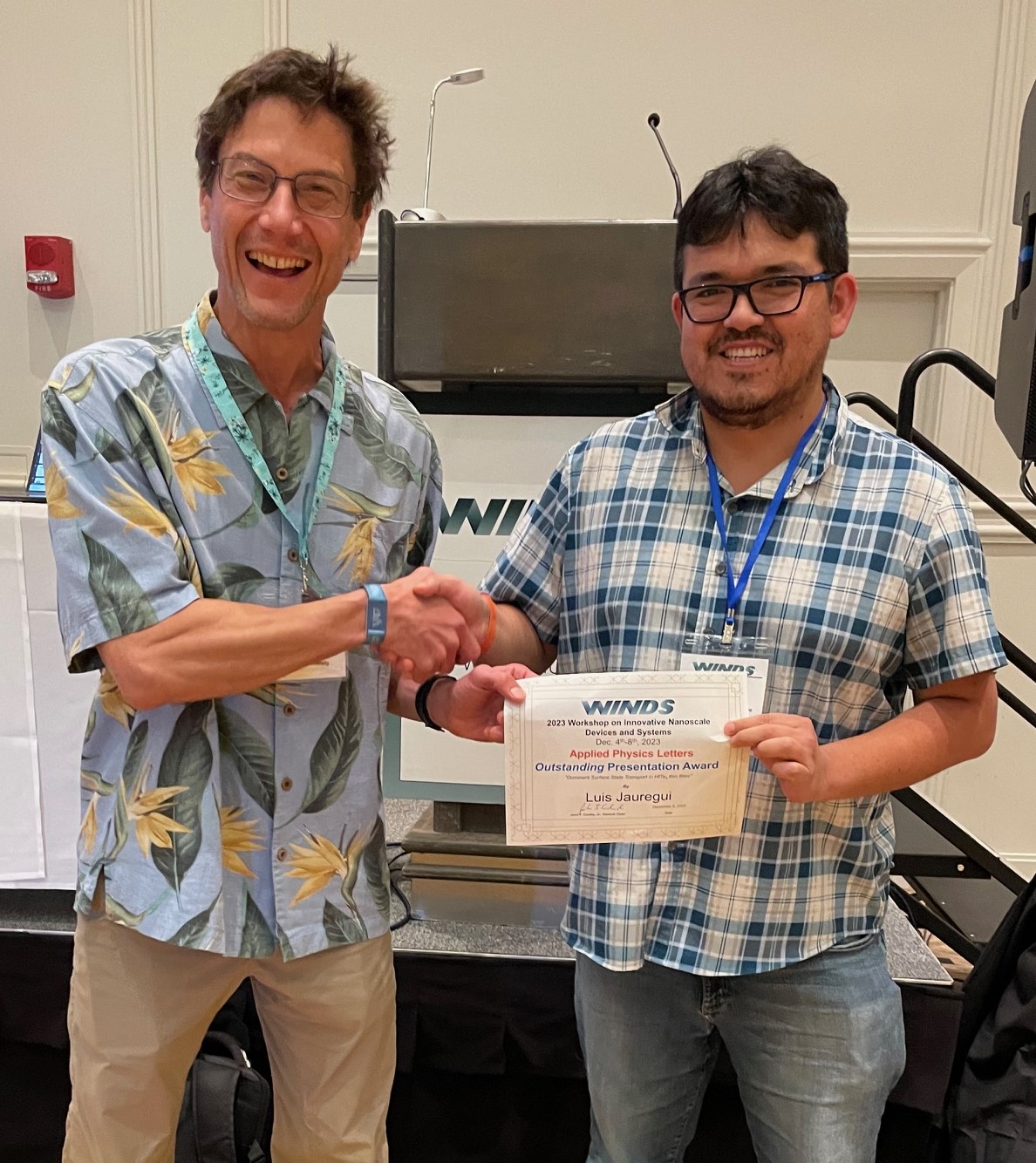
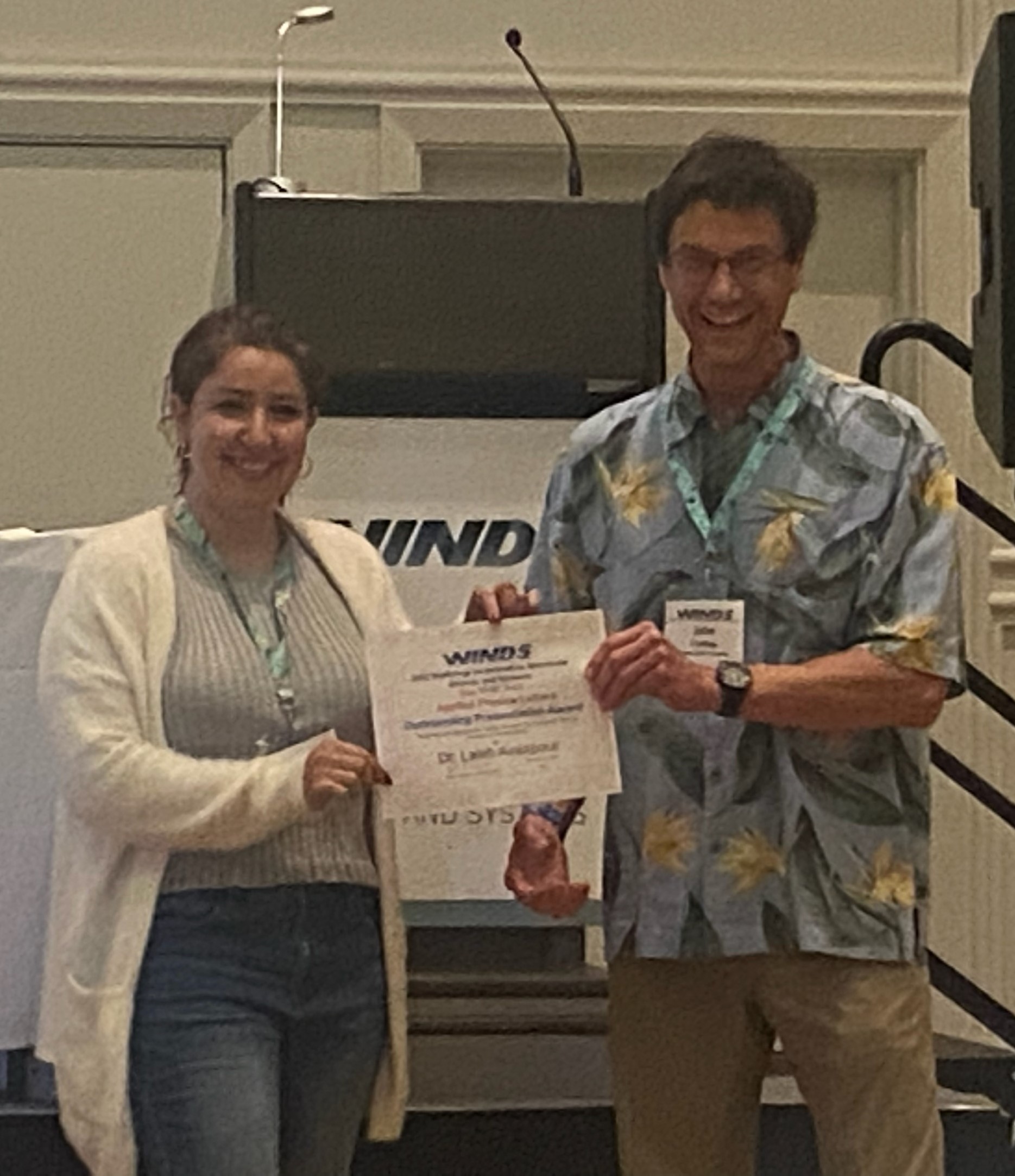
Prof. Conley presents
APL Early Career Outstanding Presentation Awards to Prof. Luis Jauregui (left) and Dr. Laleh Avazpour (rignt).
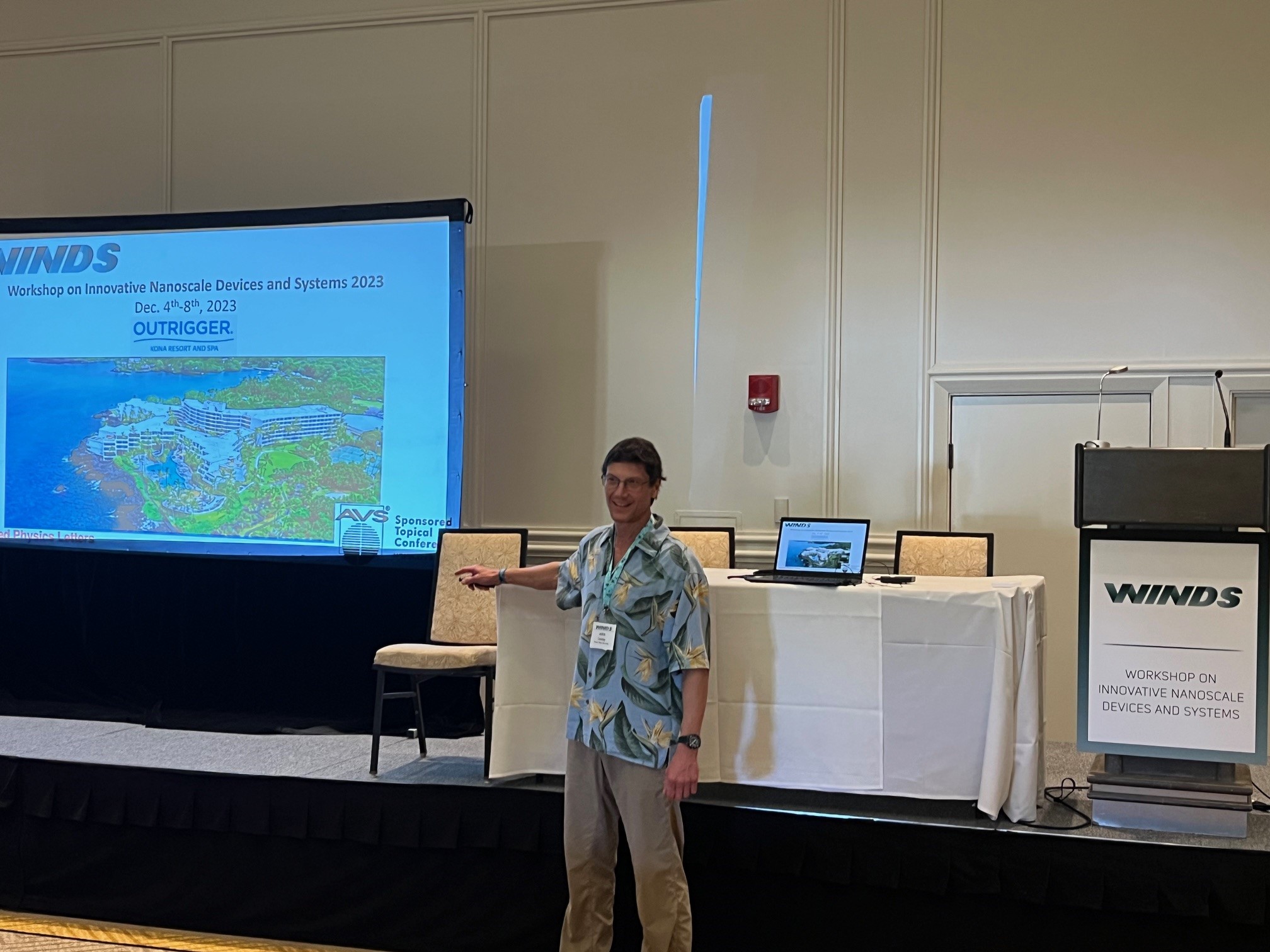
Prof. Conley opens the 2023 WINDS meeting.
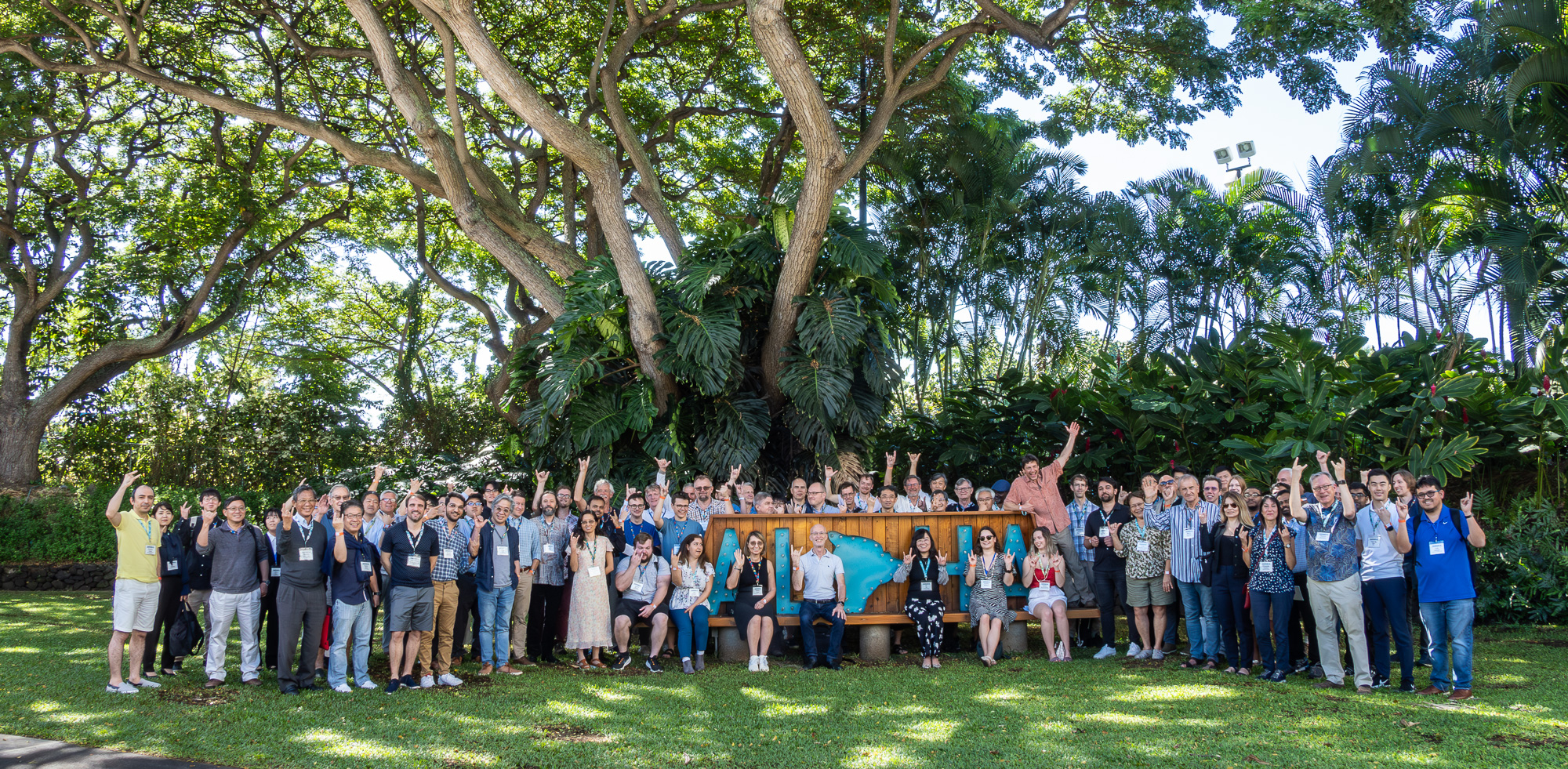
WINDS 2023 Attendee Group Photo
October 2023:
Unveiling the ALD revolution: Oregon State’s pioneering semiconductor advancements: State-of-the-art research at Oregon State University in atomic layer deposition is opening new doors for unparalleled industry collaboration and future possibilities. A new article appearing in the latest issue of Oregon State Engineering and the October 2023 issue of Semi @ Oregon State overviews research in the Conley Lab. PhD student Jessica Haglund and Prof. Conley appear in the picture below.
May 2023:
Breakthrough in Computer Chip Energy Efficiency Could Cut Data Center Electricity Use: May 24, 2023 In work led by Prof. Alan Wang (Baylor, formerly at OSU) in collaboration with Prof. John Conley, researchers at Oregon State University and Baylor University have made a breakthrough toward reducing the energy consumption of the photonic chips used in data centers and supercomputers. See full article on Environmental News Network, Communications of the ACM, KEZI, NSF, and OSU Newsroom.
U.S. Representative Bonamici visits OSU "MaSC" Cleanroom! Prof. Conley, Cleanroom Manager Chris Tasker, and PhD student Jessica Peterson gave atour of OSU Materials Synthesis and Characterization (MaSC) cleanroom to U.S. Representative Suzanne Bonamici (1st Congressional District, Oregon) as part of activities and planning around the Chips Act. Jessica and undergraduate student Joseph Karem stole the show!
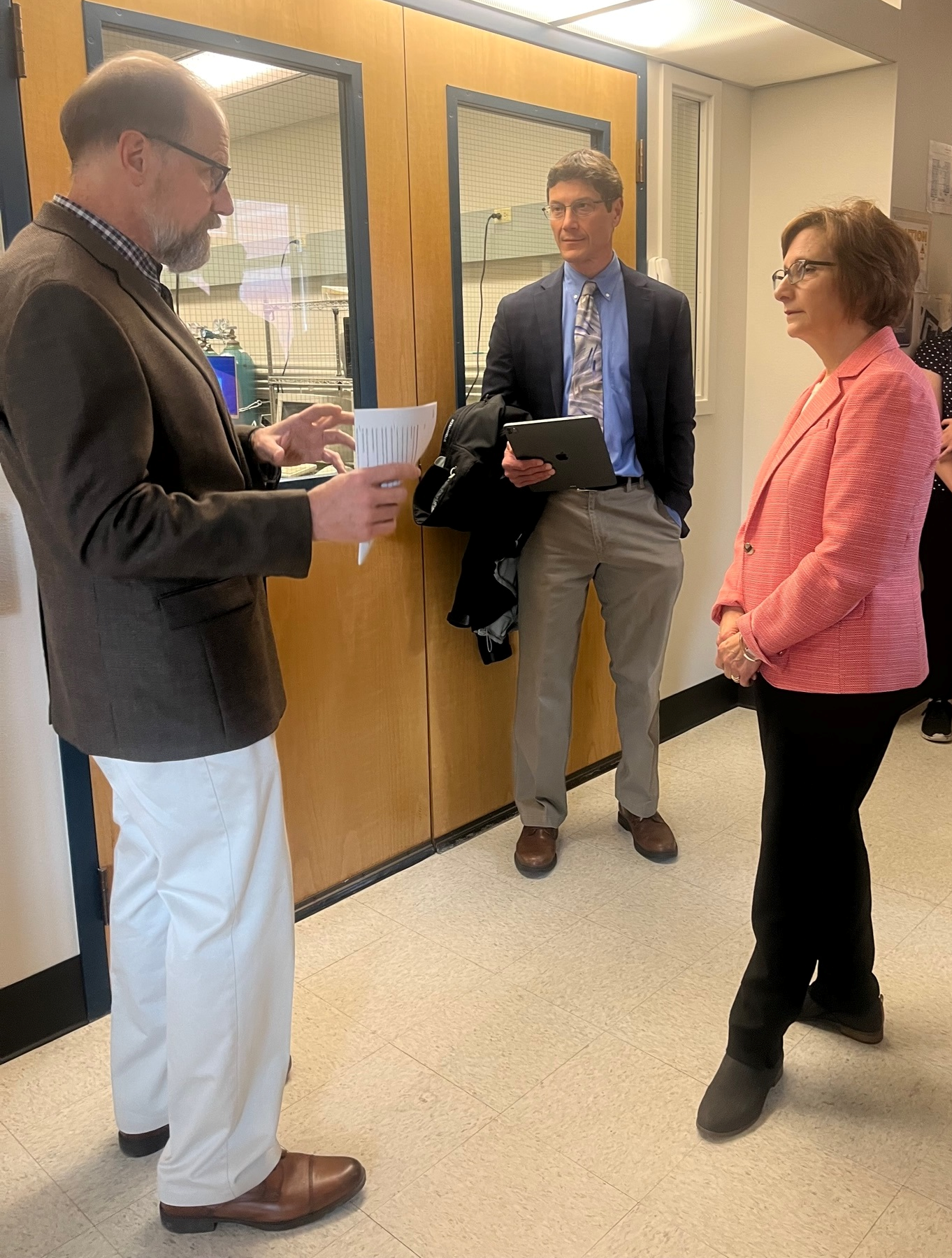
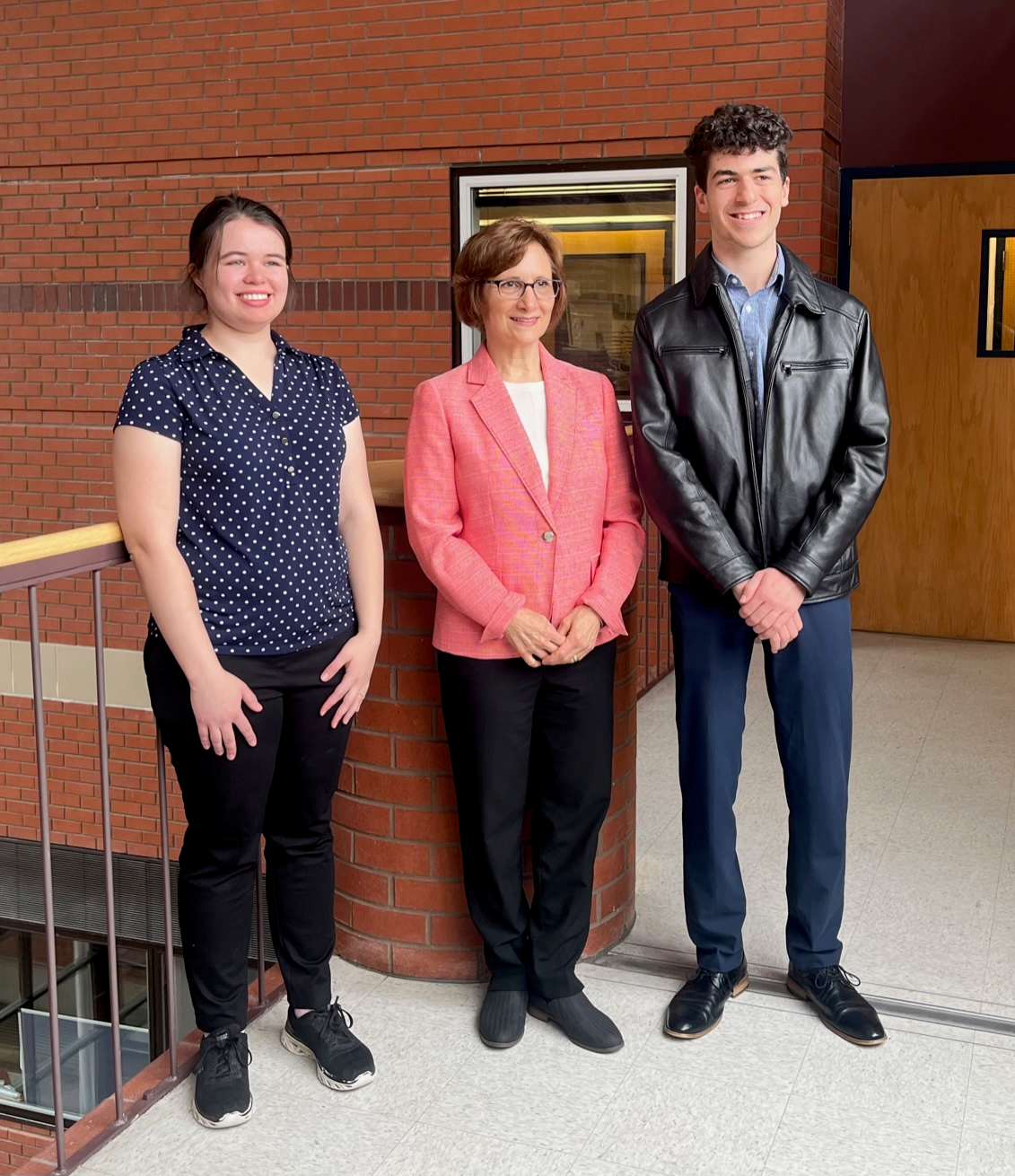
April 2023:
Kamesh Mullapudi receives Editor's Pick: Kamesh's recent ALD paper has been picked by the editor as a feature article in the AVS Journal of Vacuum Science and Technology A (JVST-A). It is entitled, "Plasma-enhanced atomic layer depositio of WO3-SiO2 films using a heteronuclear precursor," by Kamesh Mullapudi, Konner E. K. Holden, Jessica L. Peterson1, Charles L. Dezelah, Daniel F. Moser, Ravindra K. Kanjolia, Douglas J. Tweet, and John F. Conley Jr.
-Twitter: "What happens when two different ligands of a heteronuclear, heteroleptic precursor compete for chemisorption? To learn more, check out our work on WO3-SiO2 deposited for the first time via PEALD #JVSTA @AVS_Members"
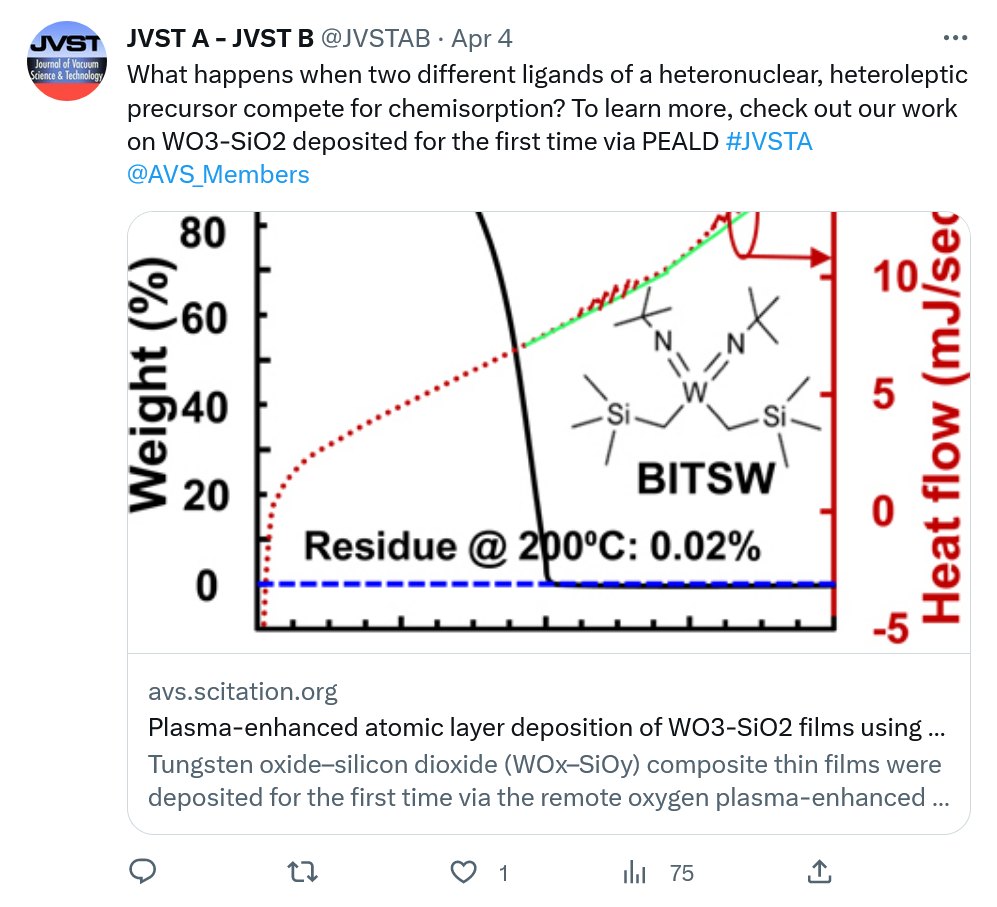
April 2023:
Group alum Dr. Konner Holden interviewed for Semi @ Oregon State: April 2023 ALD collaborations lead to workforce and next-generation packaging solutions "...Today we get an inside look at ALD from an interview with Konner Holden, a process engineer at Lam Research who earned his undergraduate and doctoral degrees from Oregon State University. Engaged in research on ALD and how it can be used for stacking/multilayer chip design, Konner first shared his academic and professional journey, his industry partnership through research at Oregon State, and finally his current work on ALD at Lam. Collaborations among academia and industry, a staple of graduate engineering programs at Oregon State, allow for mutually beneficial scenarios in which research is advanced and great hires can be made.
Getting his start in computer science and then switching to electrical engineering, Holden excelled at Oregon State as an undergraduate student, noting that he took a “deep dive into how computers work, looking at transistors, really just the heart of everything.” Staying at Oregon State for graduate school, Holden began his research into ALD under the tutelage of his advisor, John Conley, professor of electrical and computer engineering and materials science. Here Holden stated that he “began using ALD to fabricate novel electronic devices and test new materials along with new ALD processes.”
When asked why he stayed on at Oregon State for his Ph.D, Holden said, “I felt that I’d already found my home. On top of that, I had access to the Materials Synthesis and Characterization Facility at Oregon State, and there was a great clean room environment. I felt I had everything I needed and didn’t feel any reason to go anywhere else or honestly even look anywhere else.” Holden's passion for research into ALD was unabated, and he didn't miss a beat. ..." To read more, click here.
October 2020:
Prof. Conley receives Oregon State University 2020 COE Research Award: Received in a Zoom cermony during the 2020 Celebrate Excellence Awards on Tuesday, October 22nd, 2020, the COE Research Award "recognizes sustained, unusually significant and meritorious achievement in research and scholarship".
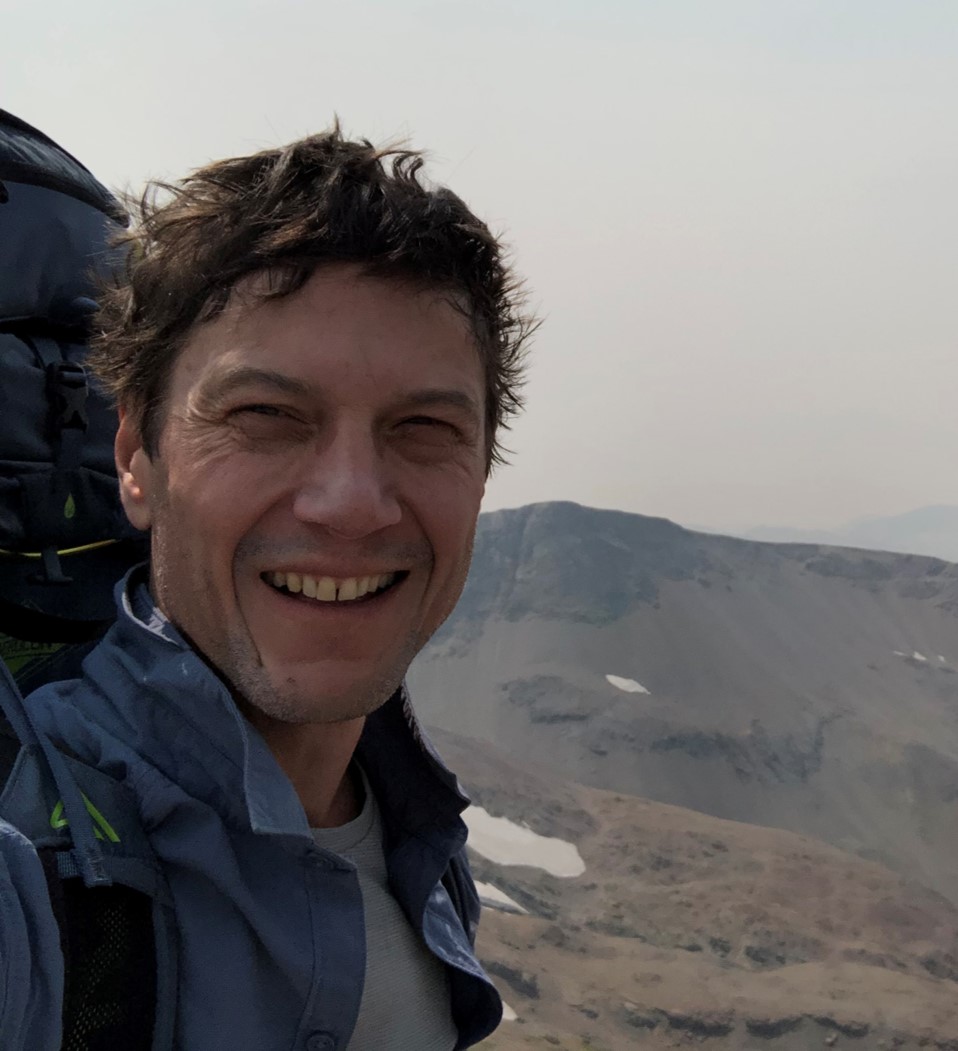
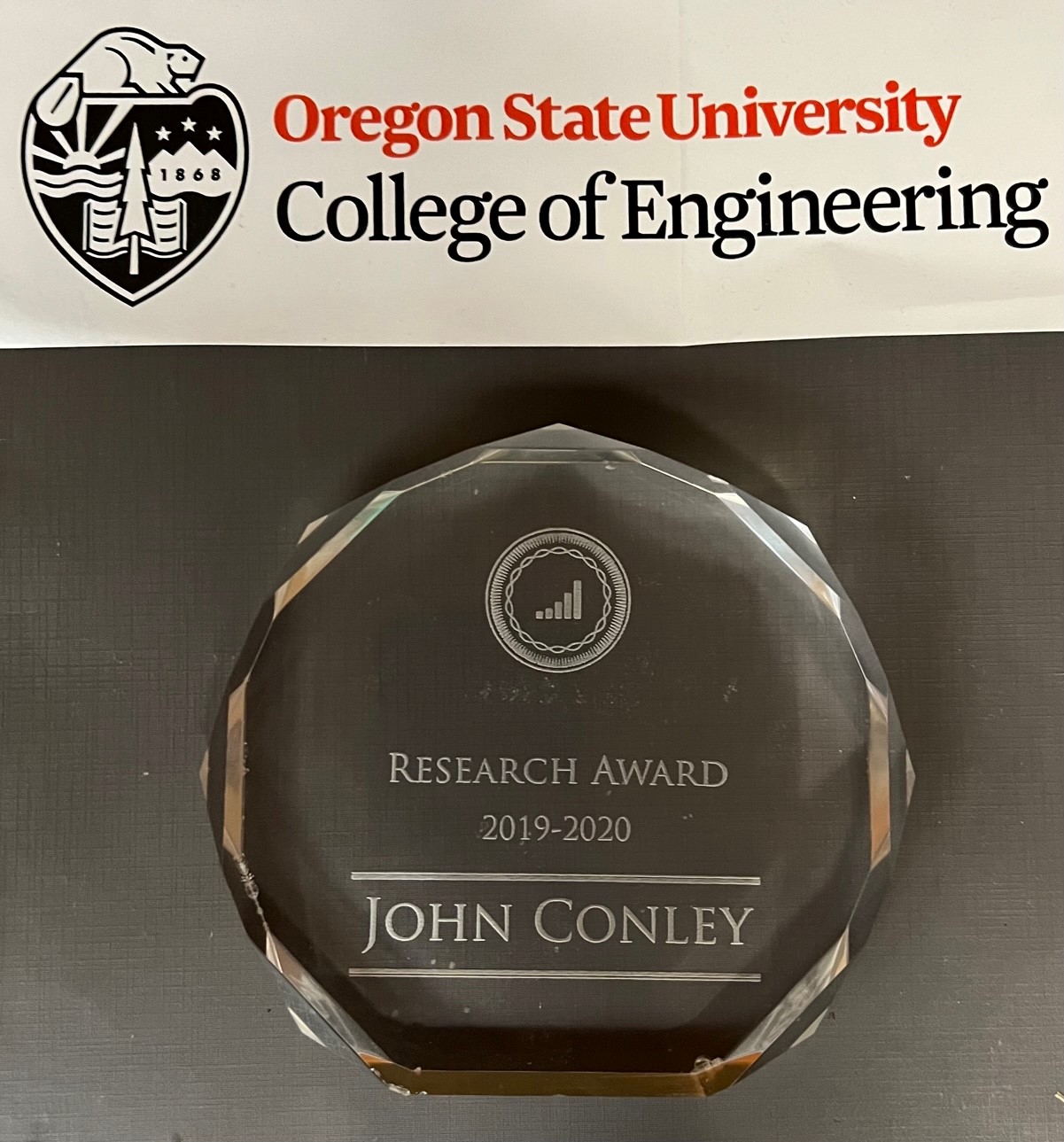
March 2020:
Prof. Conley appointed to the Editorial Board of IEEE Transactions on Electron Devices (TED): Dr. John F. Conley, Jr. was appointed to a three year term as Associate Editor beginning March 2020. Announcement appears in the Dec. 2020 issue of IEEE TED (IEEE TED Editoral Board Announcement).
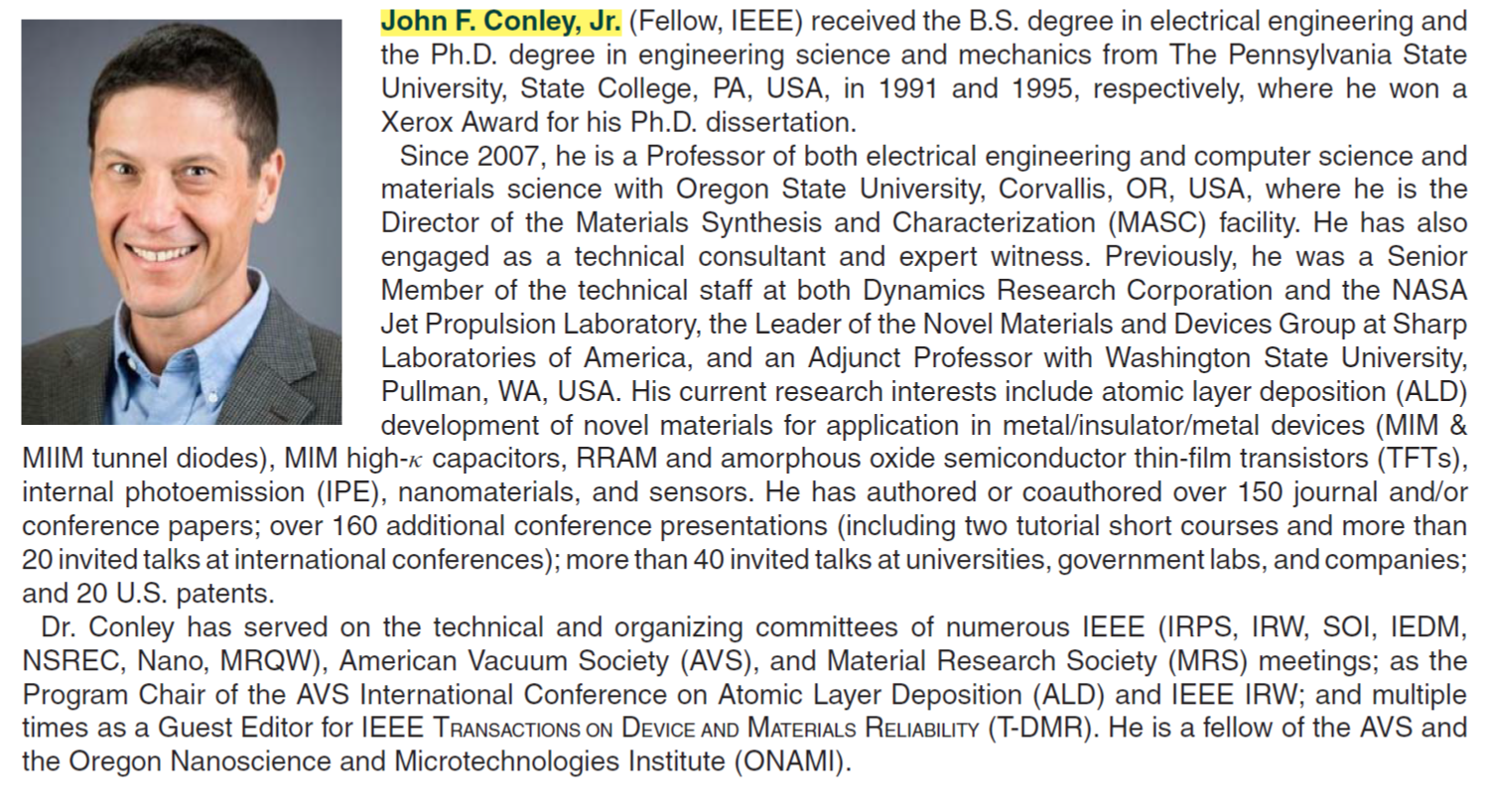
October 2019:
Konner Holden receives American Vacuum Society (AVS) Graduate Student Award: Konner received his award certificate and check on Tuesday evening, October 22nd at the AVS Meeting in Columbus, OH at a special dinner for the AVS Thin Film Division technical program commitee.
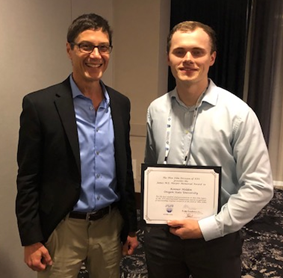
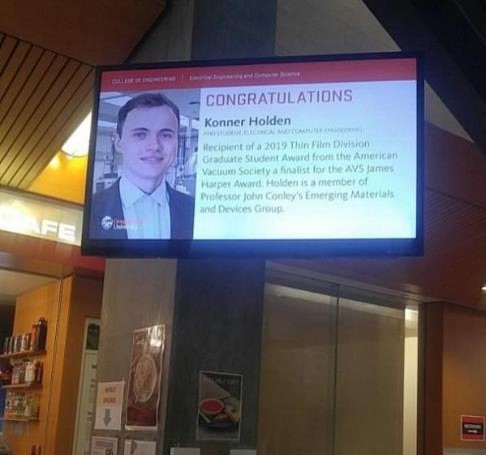
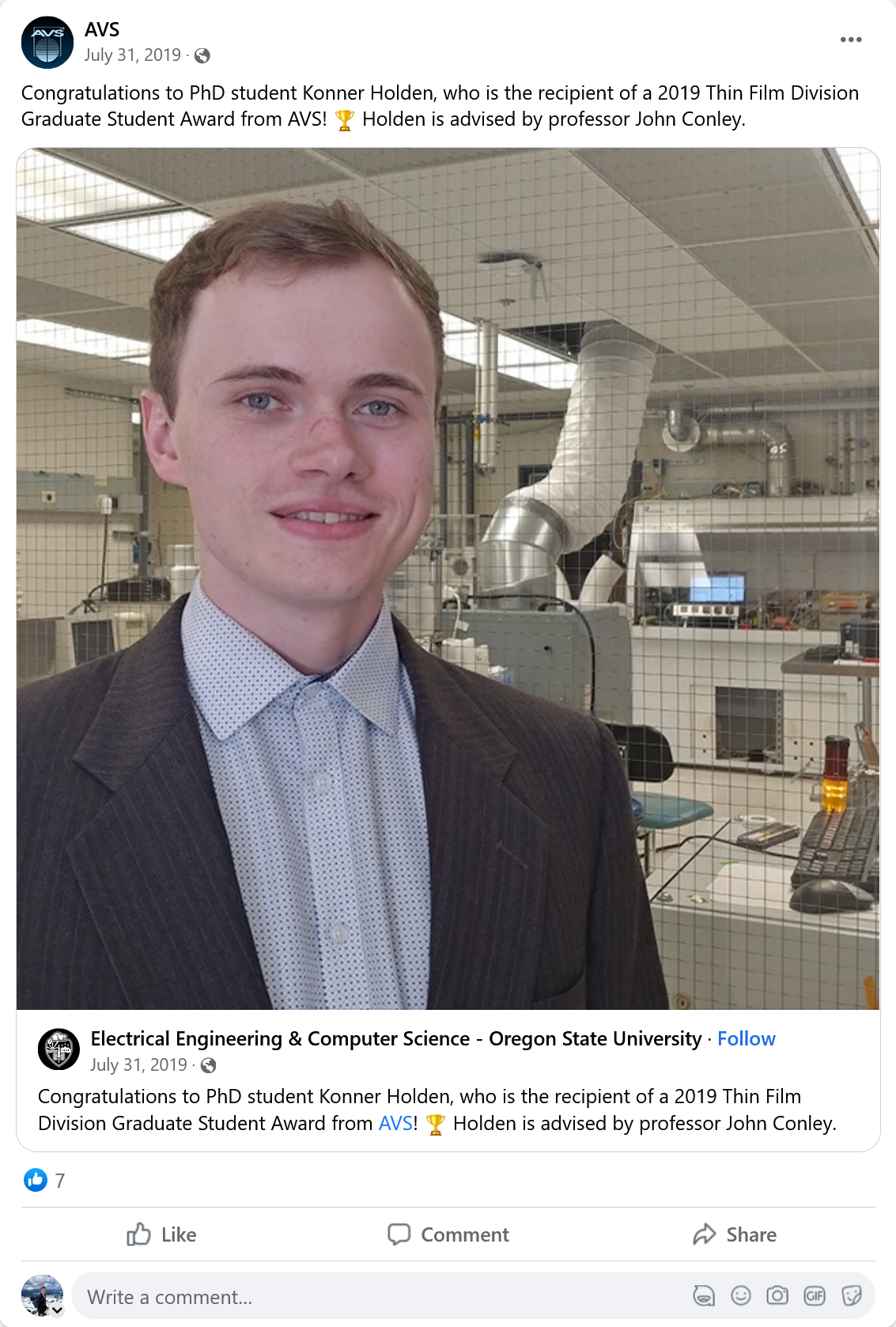
Prof. Conley receives AVS Fellow award: On Wednesday, October 23rd, 2019, at a special evening dinner ceremony, Prof. Conley was elevated to Fellow of the American Vacuum Society. Conley's PhD Advisor, Prof. Patrick Lehanan (picture on left) was there to witness. Picture on right is with Prof. Erwin Kessels.
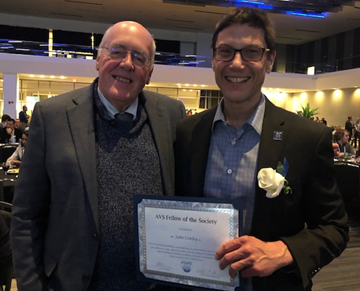
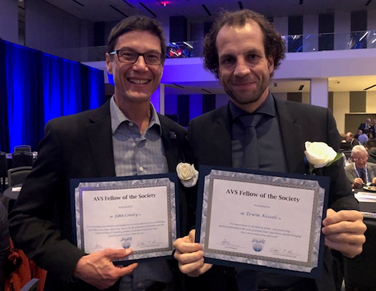
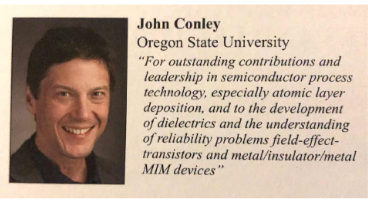
July 2019:
Konner Holden wins American Vacuum Society (AVS) Graduate Student Award: Konner Holden has won an American Vacuum Society (AVS) Graduate Student Award. This award includes a plaque and a $500 check that will be presented at the AVS Meeting in Columbus in October. Konner and his PhD advisor (me) have been invited join the AVS Thin Film Division for a special dinner at the AVS Meeting in Columbus, OH, on Tuesday night, October 22nd to receive his award. As a winner of the Graduate Student Award, he is also a finalist for the James Harper Award. He will compete in a special Monday evening session in which the four finalists will present their regularl technical research talks in a TED-talk style format. The winner will be selected that night and will receive a additional cash prize.
April 2019:
Prof. Conley Elevated to AVS Fellow: On April 29, 2019, Prof. John F. Conley, Jr. was elected 2019 Fellow of the American Vacuum Society. The AVS comprises about 4,500 members and focuses on the basic science, technology development, processing, and commercialization of materials and interfaces. This honor is reserved for those who have made significant scientific or technical achievements throughout their career, and this is a prestigious membership level that does not exceed 0.5% in any calendar year. Prof. Conley and other 2019 AVS Fellows will be honored at a special session at the 65th Meeting of the American Vacuum Society (AVS) to be held in Columbus, OH in October. Prof. Conley is also a Fellow of the IEEE.
January 2019:
Konner Holden receives another Editor's Pick: Once again, Konner's work has been picked by the editor as a feature article. This time for his recently accepted paper in the AVS Journal of Vacuum Science and Technology A entitled, "Characterization of Atomic Layer Deposited Semiconducting Co3O4".
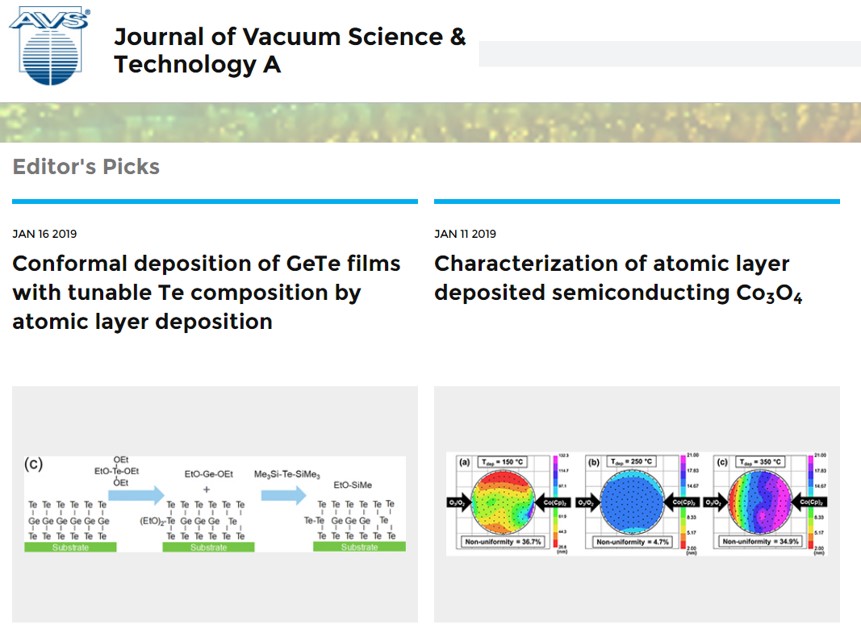
December 2018:
Melanie Jenkins wins IEEE Best Poster Award!: Melanie's poster, presented at the 2019 IEEE Semiconductor Interface Specialists Conference (SISC) in San Diego, CA, was entitled, "Internal Photoemission Spectroscopy Study of Barrier Heights between
Ta-based Amorphous Metals and Atomic Layer Deposited Insulators". She beat out more than 60 other posters to win the Best Poster Award and receiv a cash prize. Way to go Melanie!
November 2018:
Chris Tasker wins the 2018 American Vacuum Society (AVS) Thin Film Division (TFD) Distinguished Technologist Award!
The AVS TFD Distinguished Technologist Award is an international award for "exceptional technical support of thin film research or related development activities". It is granted to a maximum of one person per year. In 2017 it was won by a technician from the Eindhoven University of Technology in Belgium. This is quite an honor for Chris, Facility Manager for the OSU Materials Synthesis and Characterization (MaSC) center who is truly deserving of this distinction.
The award was presented to Chris in Long Beach, CA by Dr. Virginia Wheeler of the Naval Research Labaratory at the annual AVS Symposium after the Tuesday night Thin Film Division Dinner. Chris's wife Maggie and Prof. Conley were in attendance.The award includes a plaque, a $500 cash award, and up to $500 in travel expenses for Chris to attend the AVS International Symposium. Read more about this award at https://www.avs.org/Awards-Recognition/Division-Group-Professional-Awards/Thin-Film-Division-Distinguished-Technologists-Awa.
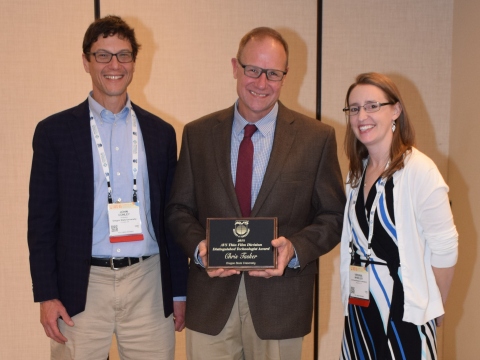
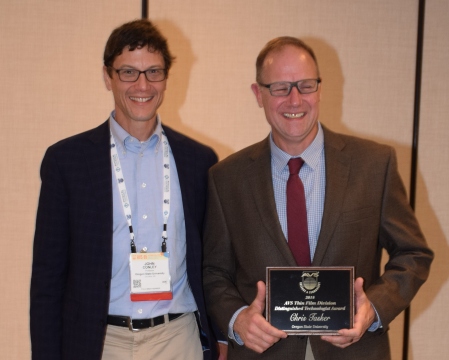
November 2018:
Conley
Group's collaboration with The University of Queensland Brisbane and the Indonesian Institute of Sciences makes frontispiece of Small: Characterization of organic nanoparticle orientation in a polyurethane foam, which exhibits anisotropic mechanical properties, remains challenging. In Atomic Layer Deposition of Metal Oxide on Nanocellulose
for Enabling Microscopic Characterization of Polymer
Nanocomposites, John F. Conley Jr., Pratheep K. Annamalai, and co‐workers briefly demonstrate the application of atomic layer deposition to enhance the contrast of nanocellulose through a coating of alumina on nanocellulose and enabling microscopic characterisation. By incorporating alumina coated nanocellulose in a polyurethane foam, it also demonstrates nanocellulose alignment in the foam‐rise direction. Access the frontispiece here.
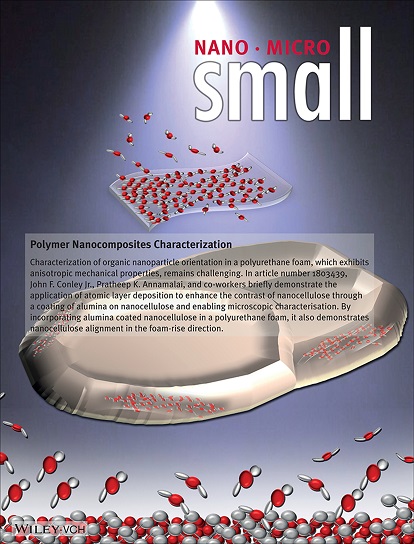
November 2018:
The Antenna Coupled THz (ACT) Film, our collaboration with RedWave Energy Inc., Univ. of Colorado Boulder, Univ. of Misouri, and Idaho National Labs (INL) wins an R&D 100 Award!Converting waste heat into power represents one of the largest opportunities for bringing greater efficiency and reduced emissions to the energy sector. Using nanorectifying antenna research from INL, RedWave Energy Inc. has developed Antenna Coupled Thz (ACT) Film capable of harvesting low-temperature waste heat at power plants. Each sheet of ACT Film is made of tiny, square, gold-wire rectennas embedded in polyethylene, plastic sheeting that can be used nearly anywhere. The ACT Film absorbs heat between 70 and 250 degrees Celsius and converts it to electricity. Conceivably, composite stacks of ACT Film could be engineered to be compatible with existing power plant designs and used to replace cooling towers. By recovering 20 percent of low-temperature waste heat at a typical power plant, the electricity generated would equal the amount produced by burning 112,000 tons of coal in a year.
The R&D 100 Awards recognize the most promising new products, processes, materials, or software developed throughout the world and introduced to the market the previous year. Awards are based on each achievement's technical significance, uniqueness, and usefulness compared to competing projects and technologies.
May 2018:
Story about Prof. Conley: Influencing Career Paths: John Conley’s career and life were shaped by his undergraduate days at The Pennsylvania State University. Read more here.
December 12, 2017:
Story about Melanie Jenkins: Seeing the Unseen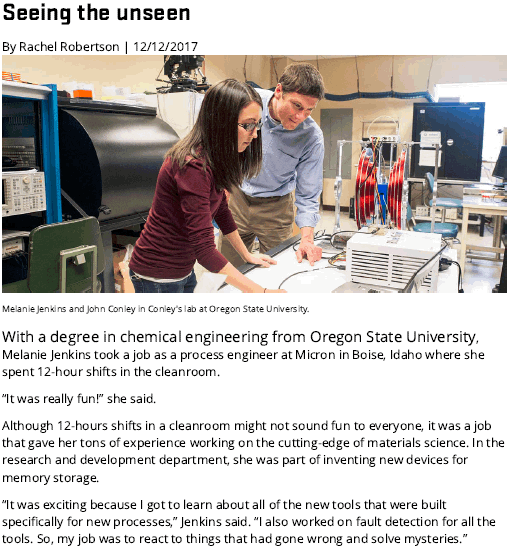
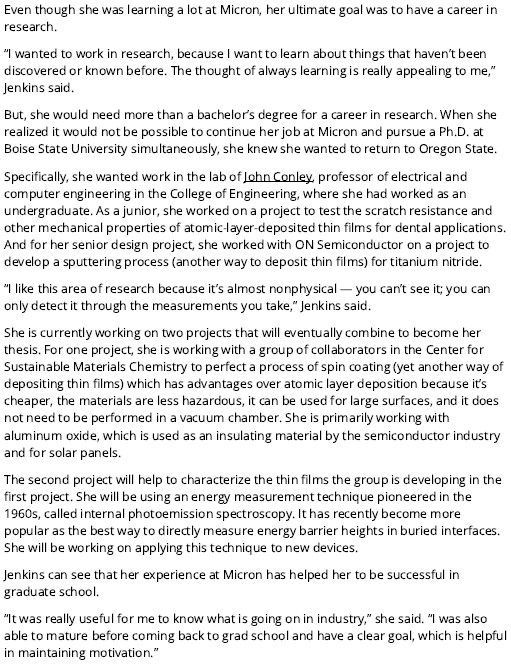

September 8, 2017:
Konner Holden wins AVS award: Undergraduate student research assistant Konner Holden's poster presentation at the Pacific Northwest American Vacuum Society (AVS) meeting entitled, "High-Voltage Nanolaminate Metal-Insulator-Insulator-Metal (MIIM) Tunnel Diodes using ALD Al2O3 and Ta2O5," by D.Z. Austin, M.A. Jenkins, K. Holden, J.F. Conley, Jr. wins 2nd place, which included a cash prize!
July 18, 2017:
Prof. Conley was the General Program Chair of the 2017 American Vacuum Society (AVS) International Conference on Atomic Layer Deposition (ALD), Denver, CO, July 15-18, 2017. The AVS ALD Conference is the premier conference on ALD and has been held since 2001 alternating between the United States, Europe and Asia. The 2017 conference comprised a carefully constructed technical program consisting of a ½ day tutorial session and 2 plenary speakers, 15 invited speakers, and 195 oral presentations arranged across 4 parallel technical sessions, evening poster sessions, and an massive industrial exhibition. The meeting was a major success and set an all time record of 923 attendees (up from just over 800 the year before) from industry, academia, and government organizations with over half of the technical contributions coming from outside the US.
Three current (Melanie Jenkins, Konner Holden, and Dustin Austin, now at Lam Research) and one former (Sean Smith, Sandia National Labs) Conley group students gave oral presentations.

June 2, 2017:
Our recent paper in Applied Physics Letters, "Electrode modulated capacitance-electric field nonlinearity in metal-insulator-metal capacitors," by D. Z. Austin, K. E. K. Holden, J. Hinz, and J. F. Conley Jr. was distinguished as an APL Editor's Pick. It was highlighted on the journal homepage the week of Jul 02 2017.
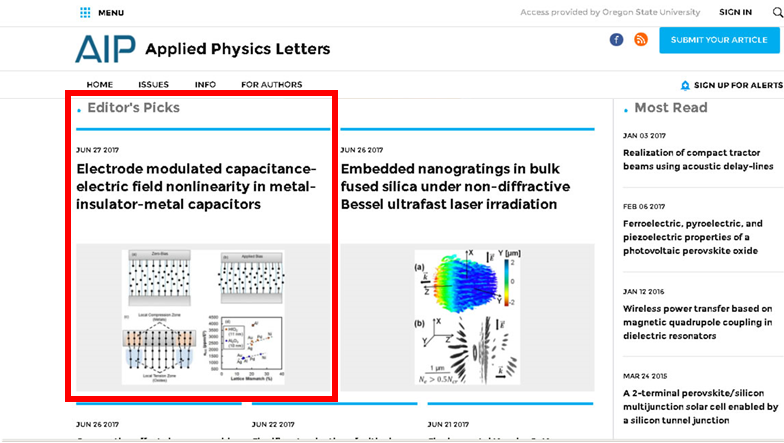
February 17, 2017:
Conley Group graduate student Kamesh Mullapudi wins "Best Poster Award for EECS" at the OSU Grad Research Showcase, for "Low-field Electrically detected Magnetic Resonance for defect detection in 4H-SiC FETs and a-SiC:H dielectrics," supported by Intel Corporation. Read about it here.

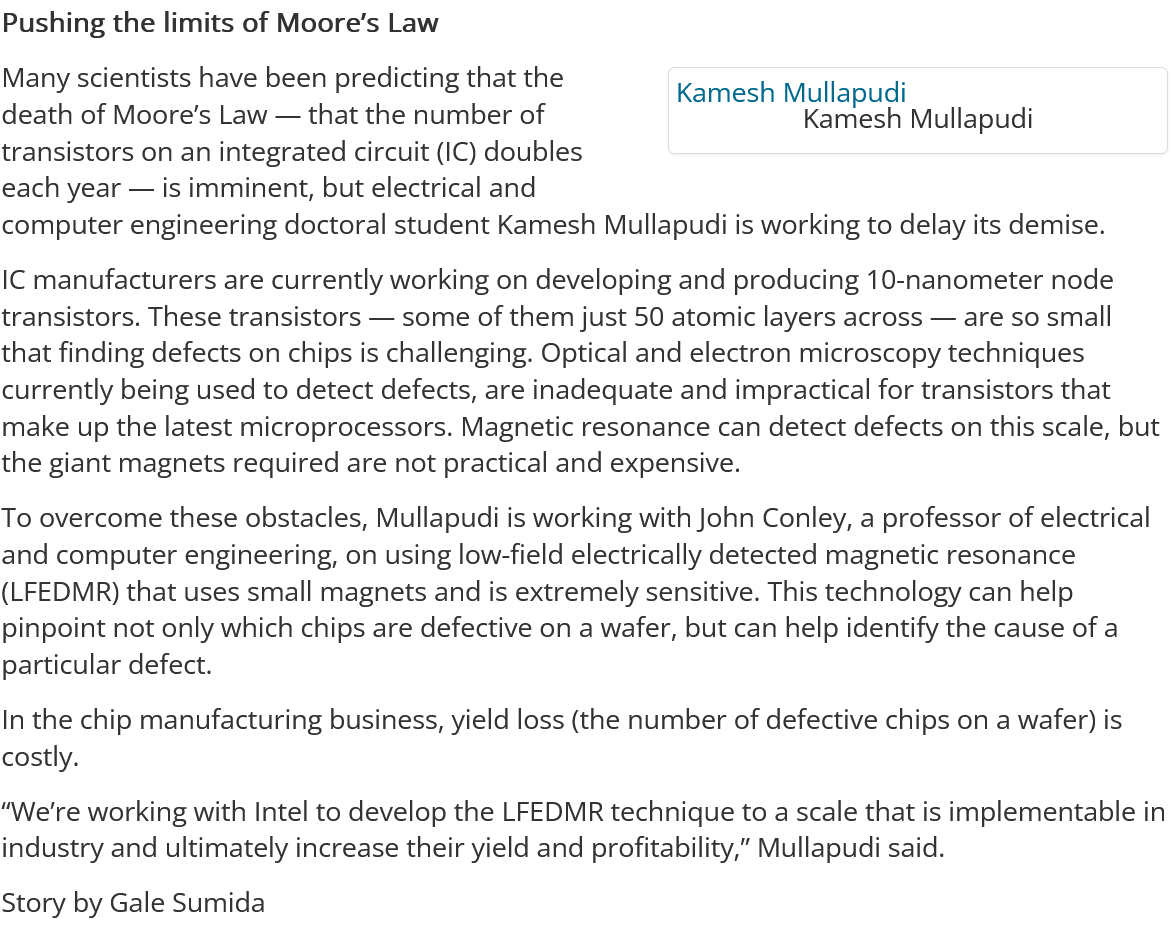
From OSU COE, School of EECS 2015-2016 Highlights, January 2017:
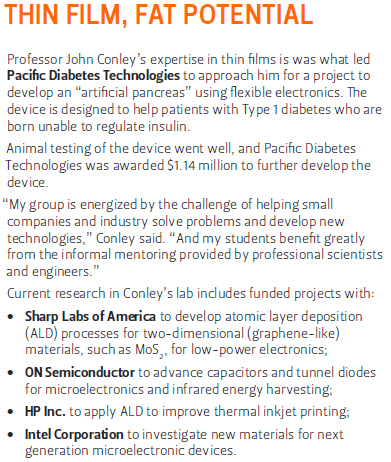
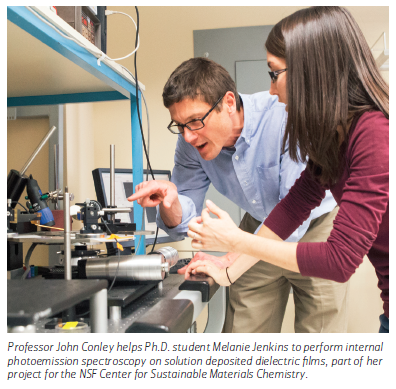
From 2014-15 OSU College of Engineering, School of EECS Top 10 Research Highlights, January, 2016: Prof. Conley and Dustin Austin areon the cover:
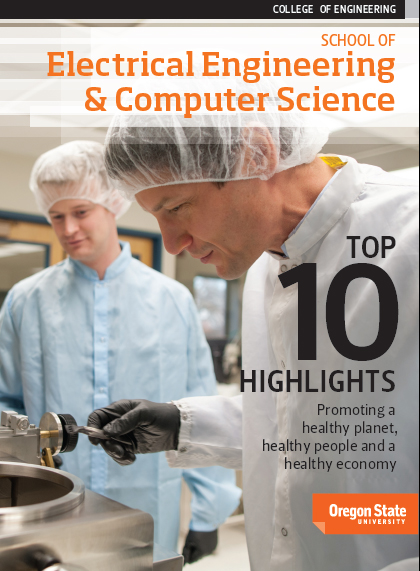
2016-2017: Prof. Conley is the Program Chair of the 2017 American Vacuum Society (AVS) International Conference on Atomic Layer Deposition (ALD), Denver, CO, July 15-18, 2017.
ALD MoS2 project (sponsored by Sharp Labs of America):
From BALD Engineering, February 2016, "Oregon State present ALD of 2D alternate channel material MoS2 on 6 inch wafers" MoS2 is a two dimensional transition metal dichalcogenide material. With a direct bandgap of 1.8 eV when in monolayer morphology, it overcomes one of the limitations of graphene - the lack of a bandgap. The work demonstrates atomic layer deposition (ALD) of one to two monolayer MoS2 over 150 mm quartz and SiO2 patterned Si wafers. Applications such as an alternate channel material for MOS devices and catalysis applications are envisioned. The paper, first authored by Arturo Valdivia and entitled, "Atomic layer deposition of two dimensional MoS2 on 150 mm substrates," appeared in JVST was selected as an Editor's Pick for Feb. 2016.
From Beneath the AVS Surface, April 2016, "Atomic Layer Deposition Shown to Produce Quality 2D Thin Films," In the latest issue of the Journal of Vacuum Science and Technology A, researchers at Oregon State University and Sharp Labs of America demonstrate how they were able to successfully use a technique known as atomic layer deposition (ALD) to deposit one to two monolayers of MoS2 on large area silicon and quartz substrates..."We found that we could consistently deposit a one-to-two monolayer 2DMoS2 film uniformly over a large surface area," Conley said. "Annealing the film in sulfur allowed us to see a strong photoluminescence peak, a hallmark of a monolayer material." .pdf
From OSU COE EECS Featured Stories, 4/27/16, "Blending electrical and chemical engineering," Making advances in two-dimensional semiconducting materials was beyond the scope of what Arturo Valdivia could imagine for himself when he was growing up in the small town of Nyssa in Eastern Oregon. But his first research project as a graduate student was not only published in the Journal of Vacuum Science & Technology A, but it was selected as the “Editor’s Pick” and was on the journal’s most read list. The article was also featured in Beneath the AVS Surface, a news publication for the American Vacuum Society... - .pdf
Glucose Sensing Project:
From Fall 2015 Momentum! (Oregon State COE Alumni Magazine) article about additive manufacturing, featuring Conley Lab student, Kamesh Mullapudi on the front cover. "Biosensors for continuous glucose monitoring"
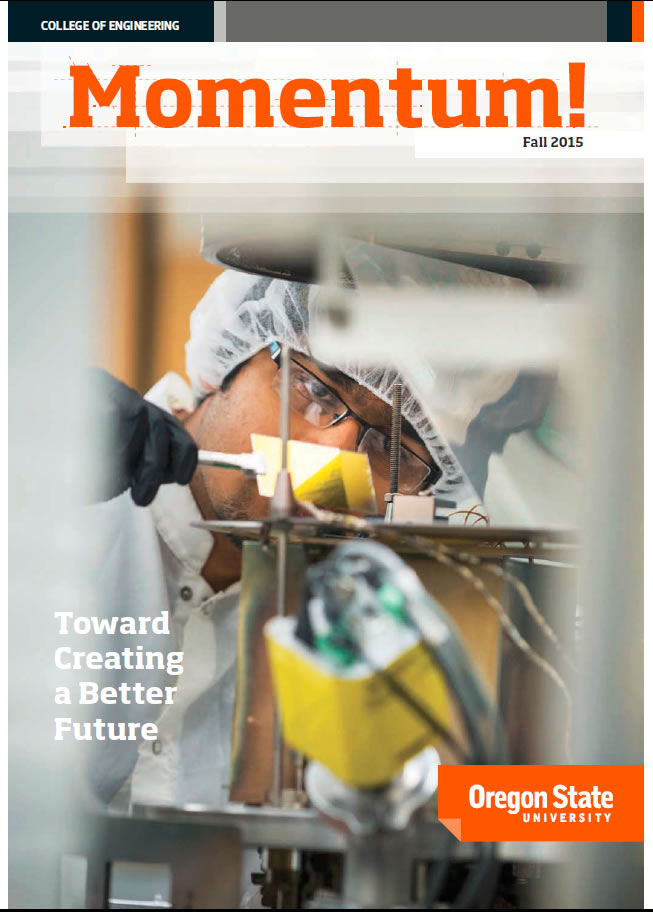
NSF National Nanotechnology Coordinated Infrastructure (NNCI) sites announced: From Portland Business Journal, 9/17/15 Northwest Nanotechnology Infrastructure (NWNI), OSU lands a piece of $4.5M NSF nanotechnology grant
Diabetes Project: From 3D Print.com:Oregon State University Researchers Turn to 3D Printing to Help Manage Diabetes17Mar2015- Engineers at Oregon State University in collaboration with Pacific Diabetes Technologieshave used “additive manufacturing” to create an improved type of glucose sensor for patients with Type 1diabetes, part of a system that should work better, cost less and be more comfortable for the patient.
Prof. Conley Elevated to IEEE Fellow: John Conley’s career honored with IEEE Fellow status - On Jan. 1st 2015, Prof. Conley was elevated to the grade of IEEE Fellow. "The total number selected in any one year cannot exceed one-tenth of one- percent of the total voting membership. IEEE Fellow is the highest grade of membership and is recognized by the technical community as a prestigious honor and an important career achievement."
Brief Overview of Conley Lab: Thin film, fat potential - Spring 2014 Momentum! (Oregon State COE Alumni Magazine) article about some of the research in the Conley Lab (see full Magazine here)
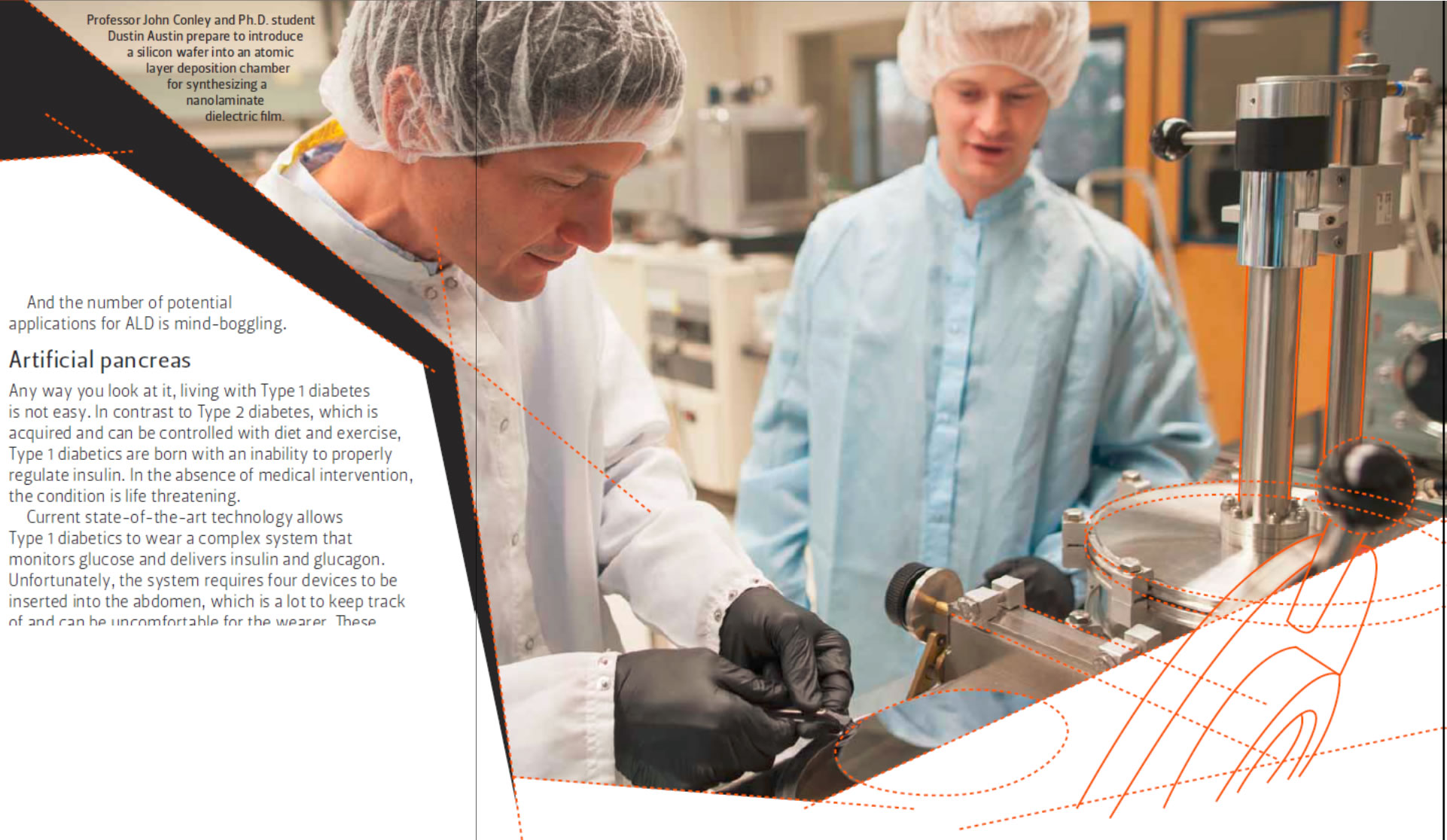
Artificial Pancreas Project: Students partner to develop diabetes breakthrough - 12Dec2013 - OSU Industry Connect article about our collaboration with Pacific Diabetes Technologies
MIIM Diodes: Quantum MIIM Diodes Beat Silicon - 6Sept2013 - EETimes.com article about our recent paper in Applied Physics Letters
ZTO Memristors: Memristors based on transparent electronics - 21Sept2012 MaterialsToday.com article about our recent paper in Solid State Electronics.
MIM Diodes: Researchers claim better 'quantum tunneling' - 1Nov2010 EETimes article about our recent paper in Advanced Materials.
ALD Facilities: 2Nov2010Arradiance Ships First Benchtop GEMStar™ Atomic Layer Deposition System to Oregon State University
Funding Opportunities
Oregon Nanoscience and Microtechnologies Institute (ONAMI)
NSF
ARL
AFOSR
DOE
SRC
OSU Quick Links
Library
Electronic Journals
Web of Knowledge
Materials Synthesis and Characterzation (MASC) Facility
Societies
Materials Research Society
IEEE
American Vacuum Society
Electrochemical Society
Misc
Lab "Family Tree" J.F. Conley in upper left, Nobel Prize winners indicated in red.
Lenahan Lab at Penn State
Pagey
